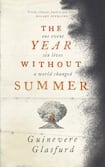
After the eruption of Mount Tambora in April 1815, 12,000 people died on Sumbawa, Indonesia. A further 100,000 died in the following weeks across the region from starvation and disease. The resulting ash cloud meant that the effects were also felt globally: there was a sudden cooling in the northern hemisphere.
Snow fell in the summer. Floods were widespread. Crop failure, famine, epidemics of typhus and cholera, and social unrest all attended the disaster. Looking backwards through the lens of later scientific research, Guinevere Glasfurd’s novel makes this link between volcanic activity and climate change explicit, exploring the ramifications on a wide cast of characters.
The “year without summer” is well known in literary history as the year which begat Shelley’s Frankenstein and Byron’s The Darkness, but Glasfurd’s second novel, The Year Without Summer, tells a series of six stories, only one of which focuses on the well-trodden story of the Romantic writers.
The authorial voice narrates most of the stories, all of which are set in the aftermath of the Tambora eruption. One exception to this narratorial strategy is the story of the labourer and servant Sarah Hobbs, which is told in the first person, and is rich with dialect whilst also managing to avoid the risk of being patronising.
It will not go unnoticed that Glasfurd's is a book of extreme weather, and is historical fiction that has a very definite sense of rhyming with our present day
Other characters are the painter John Constable, who is at the start of his career, and struggling to reconcile the poverty of the countryside, undergoing the brutality of land enclosures, with the idyllic scenes he paints. In one memorable scene an acquaintance challenges him to paint a field he has painted many times, but this time to include the fencing that has been erected to reinforce private ownership rights and to keep out the local population.
Further afield, in Vermont, US, a preacher is struggling to keep the faith amongst his flock as drought and famine begin to set in.
Narratives
Glasfurd focuses on the European and North American experiences here, though the voice of those close to the immediate disaster is felt through one of the narratives, set on board the Benares, a ship sent to investigate the explosions, which are first assumed to be caused by pirates. Much of this narrative is quite graphic, and heart-wrenching, though this is perhaps the least effective of the book’s strands.
The novel keeps its pace by moving forward in short chapters, and altering the sequence of characters we encounter, which helps to keep the reader alert. There stories which Glasfurd tells are not really intertwined, but are linked under a common theme.
Naturally, there will be characters in whom readers invest more emotional attention, or narratives which click more effectively with certain temperaments. Mary Shelley’s portion of the book, along with John Constable’s and Sarah Hobbs’s, seem the most alive, the most intriguing, but it is hard to know whether this is simply because we encounter them first and spend some of the book wishing we might return to them.
It will not go unnoticed that Glasfurd’s is a book of extreme weather, and is historical fiction that has a very definite sense of rhyming with our present day. In the aftermath of the volcanic eruption the world takes on a gloomy, apocalyptic tone: ash falls like snow; the sea appears to have turned to stone; animals starve; and people become refugees, escaping the poverty caused by the disaster.
“The season”, as one character has it, “is very backawards.”
Each story adds a dimension to the exploration of climate disaster across social class and geography
What Glasfurd achieves in The Year Without Summer is a sense of the totalising impact of climate change: parallels occur often between the lives of the richer and poorer characters, though those with money always fare better. However, the social unrest that underpins the novel adds a brimming energy, and a sense that a small spark might set the whole social structure ablaze.
Engrossing
If these narratives make the novel appear sombre, gloomy, then that is right to a degree. Yet it is also engrossing and easy to read.
Though some of the characters are less interesting than others, and could perhaps have been cut without much damage to the overall experience, this is a rich, well-written, and entirely convincing work of historical fiction. Each story adds a dimension to the exploration of climate disaster across social class and geography.
It is well researched, a hybrid between literature and environmental history, but wears its research lightly. What is most interesting about the book is its function as a parable. Paradoxically, in The Year Without Summer we are offered both a vision of the past and a vision of the future.










